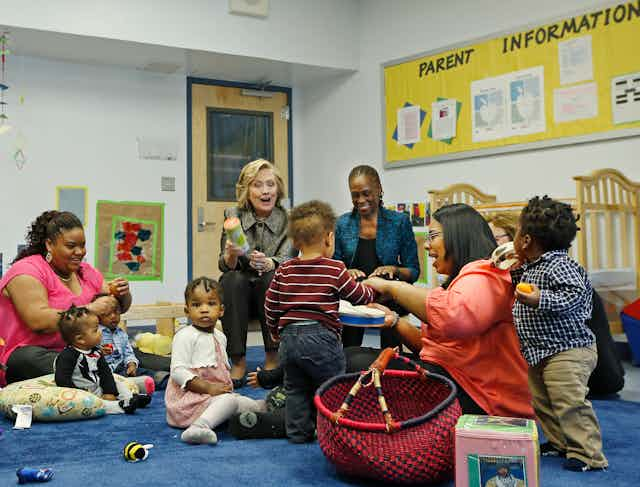Donald Trump, during his speech reacting to the Orlando shooting, famously accused Muslim extremists of “trying to take over our children”. He previously promised to look Syrian children “in their face and tell them they can’t come here”.
Trump’s rhetorical turns to the child – typically sudden, whimsical and outrageous – contrast with the Clinton campaign’s consistent focus on children, often promoted through linking her policies to her role as grandmother. Yet her campaign recently tapped into a more politically brutal tradition than this suggests.
The Clinton campaign used children to visualise the consequences of a Trump vote in its recent video, “Role Models”. This deploys the child as image of the future. But it’s an image with a past. It continues a tradition of using children to present apocalyptic possibilities to the American electorate.
The film opens outside rural and urban American homes at sunset before showing children inside watching Trump: Trump joking about shooting people; Trump calling Mexicans rapists; Trump suggesting a female reporter is menstruating; Trump mocking another reporter’s disability; Trump wishing that protesters could be “carried out on a stretcher”. This is spoken over the ethnic and gender mix of the children’s faces.
These clips have already been widely repeated; their value here lies less in the content than its frame. Children are watching – and in case you hadn’t noticed, these words also appear as text on screen.
This tactic echoes previous appearances by the child in presidential campaigning. The most infamous came in “Daisy”, President Lyndon Johnson’s 1964 advert against Senator Barry Goldwater. A little girl pulls apart a daisy, counting the petals, only for her voice to be suddenly overlaid with a booming male voice counting down to a detonation. The camera rushes into the girl’s frozen eye; within it we see a flash, then a mushroom cloud. Johnson himself intones: “These are the stakes. To make a world in which all of God’s children can live, or to go into the dark.”
Daisy was immediately denounced as outrageous. However, a campaign “for the child” delegitimises its opposition – to be against the child is inconceivable. Johnson’s point, though, was that the use of nuclear weapons was inconceivable, a taboo Goldwater (like Trump today) undermined.
Although no evidence shows that Daisy directly influenced voting, its association of Goldwater with the nuclear risk stuck. It continues to be prominently remembered; its 50th anniversary in 2014 produced a spate of comment as did the 2011 publication of Robert Mann’s monograph Daisy Petals and Mushroom Clouds.
In Daisy’s shadow
Johnson’s introduction of a child as political visual left a legacy. Though the child had been prominently used in political rhetoric before 1964, it was Daisy’s visual force, only four years after television first played a major role in a presidential election, that was new. The intensity, still startling today, in its penetration of the child’s eye to find the bomb inside, left a model for others to intimate impressions made on the child behind her innocent – or inscrutable – face. During the post-1960s “culture wars”, the Christian right’s tactics were (and continue to be) influenced by this model, basing repeated campaigns on such visuals.
In the 1990s, (Bill) Clinton Democrats partially reclaimed the child from the GOP, notably through the first lady’s book, It Takes a Village. Then there was Hillary Clinton’s 2008 anti-Obama ad, “3AM”, which began outside an American home at night before rolling over several sleeping children and then cutting to a phone ringing at 3am in the White House. “Daisy”, “3AM” and “Role Models” all focus on the child’s face in extreme close-up, a technique they noticeably share with horror movies about children being taken over by some malevolent force.
Role Models draws on the 2008 example, but also reaches back to 1964. In May 2016, the Daisy creators discussed reviving their visual tactics against Trump; intentionally or not, Role Models answers this proposal. Clinton’s closing message echoes Johnson’s; the penetrating gaze of the camera on children’s faces similarly reflects extreme anxiety over the internal effects on the child of what she sees.
Role Models has attracted outrage: one right-wing news site echoed reactions to Daisy in arguing:
Using children … immediately posits the source of the ad as exploitative, and that goes double for attack ads in which the message is supposed to be that children shouldn’t be exposed to something.
Despite this, Role Models may “work”. But although its individual effects on voters will (as in 1964) never be conclusively known, it has started a serious conversation about the effects of election rhetoric on children.
So do we have anything to be concerned about here, or is the child a legitimate and necessary tactic?
The child, the image of the future, can be used to avoid addressing the disenfranchised of the present, as cultural historians like Lee Edelman have argued. The children in these ads seem to embody the future in the abstract only, calling to be saved from something catastrophic, but avoiding particularities – social, economic, ecological – that are likely to significantly differ from the present.
In these ads, the future appears as a matter of moral survival rather than, as another Clinton book argued, of “hard choices”. This tactic loses something of what it tries to protect: attention to the conditions of the child’s future.
Meanwhile, the child’s political impact, like their future, is uncertain. Will the children of Role Models be another Daisy, or a Syrian child we can look away from – perhaps feeling that we’ve been exploited by the child’s image for long enough?

